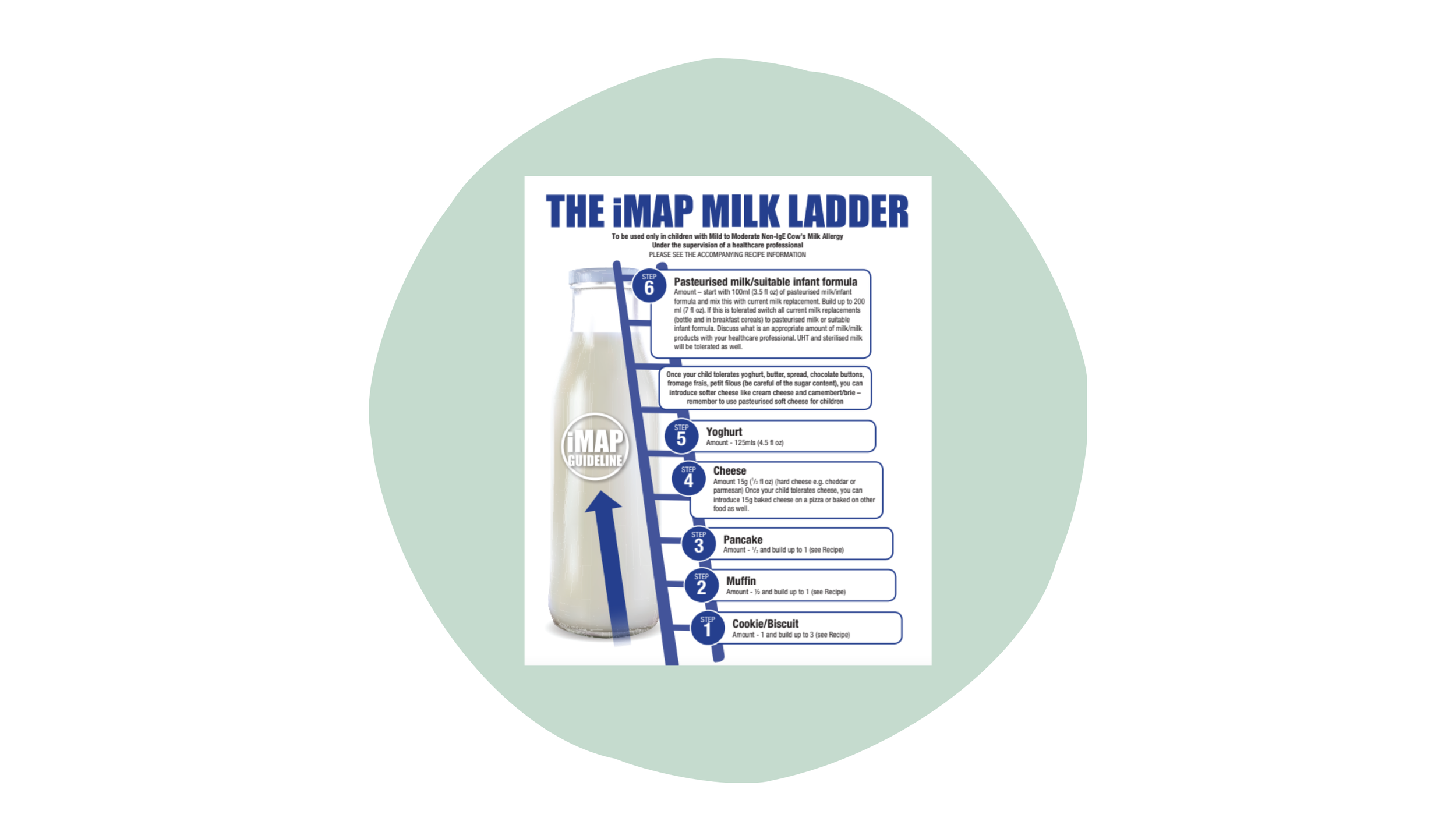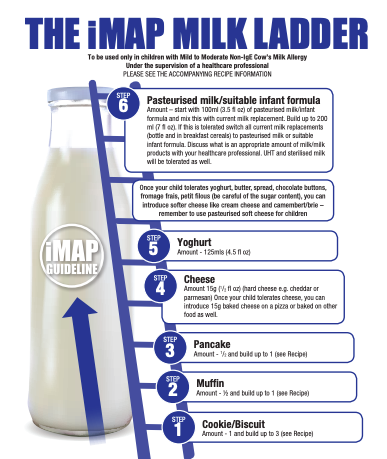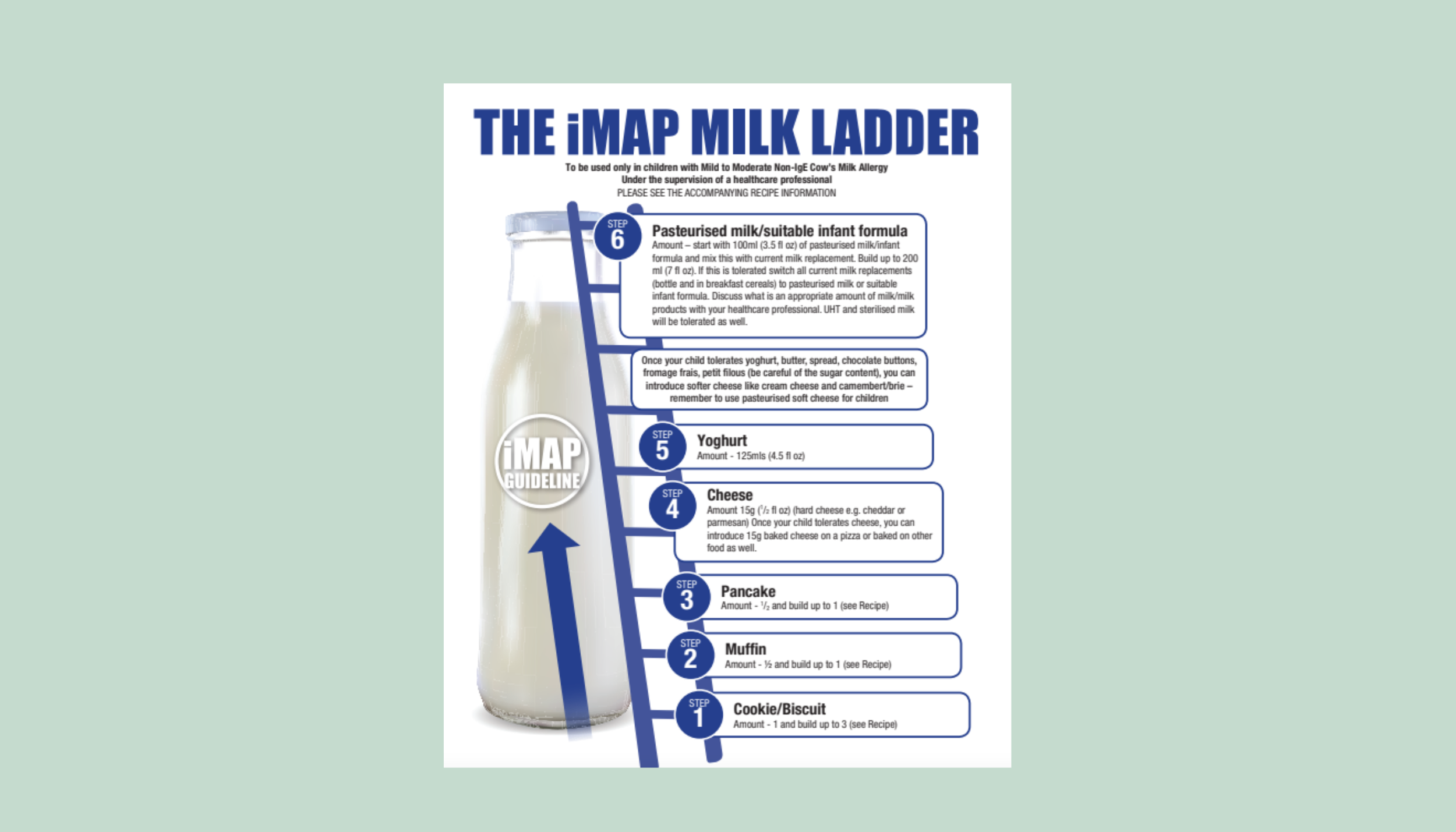What is a milk ladder challenge?
All your questions answered about the milk ladder challenge. Written by Registered Baby and Child Dietitian, and Milk Allergy Specialist, Christina Hills.
Once your child’s allergy is stable, you may be wondering: when will they grow out of it?
This is where food challenges like the milk ladder come in.
So, what is a milk ladder challenge?
Most babies with a mild milk allergy will at some point be recommended to do a home milk challenge to see if they have outgrown their milk allergy.
The milk ladder is a structured, home-based way to reintroduce milk in stages.
Each step of a challenge introduces milk in a slightly more allergenic form, which helps the immune system re-learn to tolerate it gradually.
This could look something like this:
Cooked milk - in a flour matrix (progressing from more cooked e.g. biscuits, to less cooked - like pancakes)
Cheese
Yogurt
Fresh milk
Your dietitian will guide you on which ladder to use and how many steps to take etc (more on this below).
When should I start a milk ladder challenge?
For non-IgE allergies
According to iMAP (International Milk Allergy in Primary Care), the milk ladder can be started six months after diagnosis or when the child is around 9-12 months old
Emerging evidence suggests that the ladder may be started earlier in some specific sub-types of non-IgE milk allergy, although this is not reflected in UK guidelines yet (for example in those with allergic proctocolitis AKA blood in stool)
For IgE-mediated allergies
If your child has an IgE allergy, you must have guidance from an allergy specialist team before starting
Some children may start as early as 6 months, but this ALWAYS depends on individual risk factors
Getting started
Before you start you need to make sure your child is well (although this may in itself feel like a challenge). Use this checklist before you start:
Your child should be well – no illness, teething, belly bugs or other issues
No vaccines due
No new medications that might have side-effects
Eczema should be under control
You should feel confident in what a milk ladder is and what to do at each step
What are the different types of milk ladder?
There are several versions of the milk ladder out there, a simple google search will show you lots of results.
The main ones used in the UK are:
iMAP 6-Step Ladder – the most widely used in the UK
iMAP 12-Step Ladder – a slower, more gradual approach
BSACI 4-Step Ladder – used in some UK allergy clinics - although I feel this jumps massively at step 3! Which is not suitable for many babies and young children with more sensitive food allergy
Indian and Mediterranean Ladders – these versions have been adapted for different cultural diets
This guide is mostly based on the 6-step iMAP milk ladder, pictured below, as this is what is more commonly used in the UK.
If your child has been recommended to start the 6-step iMAP milk ladder, ready my guide to step 1 here.
What are the steps of the iMAP milk ladder?
The 6-step iMAP milk ladder has the following steps:
A small amount of milk or milk powder extensively heated milk in a wheat matrix (e.g. biscuits, cake)
Milk baked in a recipe (e.g. muffins, scones)
Milk in a flour matrix cooked for less time OR milk used in a baked recipe (e.g. pancakes; or a shepherds pie/pasta bake)
Cheese
Yoghurt
Cow’s milk itself
Recipes vs shop bought options for the milk ladder
Many ladders consist of recipes for the first few steps and rely on parents cooking or baking foods containing milk. Check out the biscuit recipe for step 1 of the milk ladder here. If you do decide to use shop bought options just be aware that the amount of milk protein is unknown, so just go a little more cautiously on each step.
How much to give on each step?
This depends on the child and their previous reactions:
For mild IgE reactions in the past, you might start with a crumb
For non-IgE allergies, you may start with half a normal baby portion and gradually increase
Always get personalised guidance from your dietitian about what is safe for a home challenge. Check out my complete guide to step one of the milk ladder here.
How long should we stay on each step?
This varies from child to child:
If they are tolerating a full portion at one step and they have had a full portion, you can consider moving on
There is no need to rush: gradual exposure is key- and part of the goal of the ladder is to PROMOTE TOLERANCE but exposing to small amounts of low-allergen milk - not simply to PASS the ladder on first try
Some children may need weeks or months at one step before progressing upwards!
What to watch for
Every child is different. Some common signs of a reaction might include:
Skin symptoms: hives, rashes, redness, swelling
Tummy symptoms: vomiting, diarrhoea, bloating
Respiratory symptoms: cough, wheeze, sneezing (less common in step one)
Stop the ladder and contact your dietitian, doctor or allergy team if you see any signs you’re concerned about
What if my child reacts?
First, ask yourself:
Could this be teething, illness, or a medication reaction?
Are symptoms mild (e.g. a bit of tummy upset, reflux, change in poo, unsettled behaviour, sleep issues) or moderate-severe (e.g. vomiting, hives, breathing issues)?
If there is a mild reaction:
If baby has a mild reaction at step 1-3 → We usually advise to wait around 2-3 months before retrying
If only a tiny amount caused a reaction (e.g. a crumb) → We might advise you to wait even longer than this- 5-6 months before retrying again
However, there is no blanket rule and it really depends on the individual get individual guidance from your dietitian if unsure!
Breastfeeding and the milk ladder
If I am breastfeeding, can I do the milk ladder?
🤱 For breastfeeding babies with milk allergy, I usually recommend to go straight to baby first when it comes to doing a milk challenge, as babies are usually 9-10 months or older when they start a milk challenge and so are capable of eating a wide range of foods
I find this way around it avoids any uncertainty - as you know how much milk protein your baby is having and how much they can tolerate. That way it is also clearer if your baby reacts to a particular food - we can take it out and put it back in again more easily
With breastmilk it can take hours (and in some cases days) for milk proteins to leave breastmilk
Once baby tolerates milk in their diet, mum can reintroduce dairy into hers
That said, some babies do not like the foods we suggest to offer as part of a milk challenge (although I’ve got lots of tips if this sounds like your baby!)
There are also some benefits to giving your baby milk via your breastmilk- it is diluted- only a very small proportion of your milk contains intact milk proteins- so this may feel more reassuring to you if you are nervous about introducing milk to your baby
What I would suggest is wait for your little one to be symptom free and then add some dairy back into your diet and see if baby has a reaction. If they do, stop and take it back out again and wait for symptoms to settle before giving any milk to your baby or starting a milk ladder
Where to go next?
If your child has been recommended to start the 6-step iMAP milk ladder, ready my guide to step 1 here.
Want more?
If you’d like one-to-one guidance to support a milk allergy diagnosis, reintroduction, or allergy-safe weaning, I offer 1:1 personalised consultations online in my virtual clinic to help you feel informed, and supported through every stage of your child’s allergy journey.
Each initial booking includes a full written report after the session and 2-weeks of email support to provide that extra layer of care. Book now and we could be speaking as early as today!






